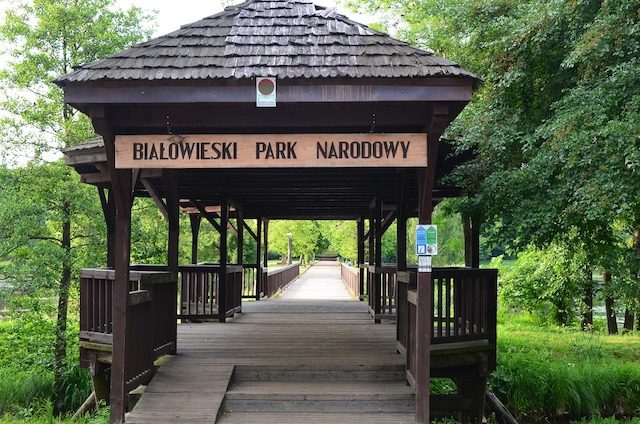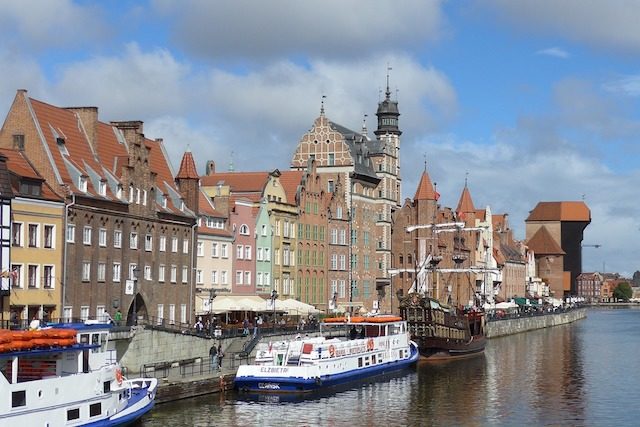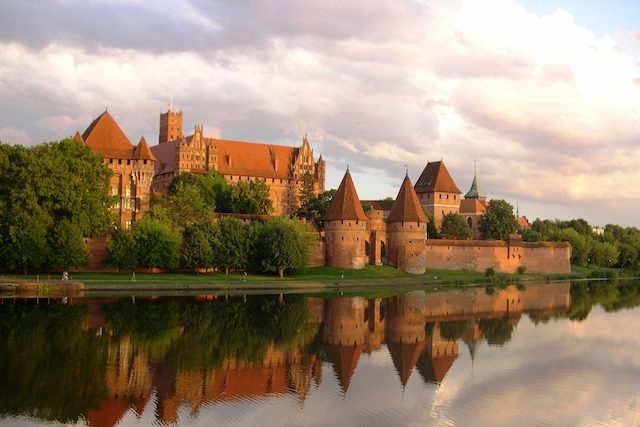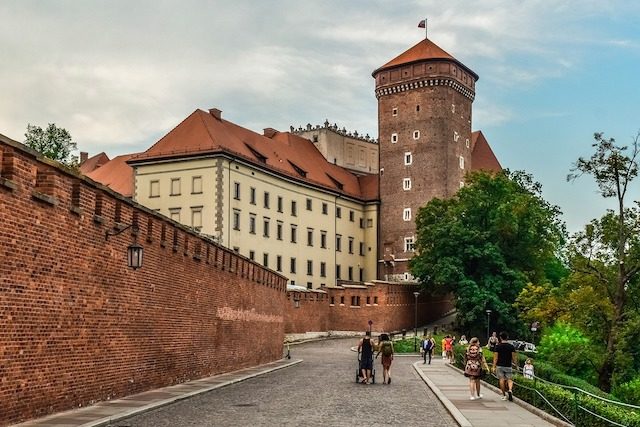Poland. A land of record holding attractions. A heavily wooded country in places, beautifully urbanized in others, Poland is a gem of European intrigue with a complex history scathed by the tragedies of armed conflict. In this account, we showcase a visitor’s 10 must see sites in surprising Poland, including the world’s largest castle and a mysterious forest.
10. Malbork Castle
Did you know that “The King of Castles,” the largest castle on the planet (by land area) is in Poland? Poland’s Marlbork Castle is a medieval gem that should rank well in any world itinerary of castle tours. Built in the 13th Century, Marlbork Castle, known as the Castle of the Teutonic Order in Malbork, consists of a castle and associated fortress construction close to the Polish town of Malbork. A UNESCO World Heritage Site, the magnificent building attracts visitors looking to tick “biggest castle” off the touring achievements list.
Marlbork Castle is near the River Nogat in northern Poland, built out of brick and typifying Gothic architecture. The construction reflects the Teutonic Order state located in Prussia, where militant German monks fought crusades against Prussian and Lithuanian pagan tribes from the south coast of the Baltic Sea. The crusaders also attacked the Kingdom of Poland, a Christian Kingdom. Thus, the castle is seen as a symbol of the violent religious conflict that embodies much of Europe’s grand but often troubled history.
9. Bialowieza National Park

The primeval forest of Bialowieza National Park is the refuge of the majority of the world’s few remaining European bison, Poland’s national animal. Also designated as a World Heritage Site, the huge relict tract preserves the last of the temperate forest that once grew lush and mysterious across much of the European continent. The first national park to ever be established on the European continent, Bialowieza was declared a protected area in 1932 and stands out for its exceptional diversity. Along with the huge bison, other species seen here include lynx, wild boar, wolves and red deer.
Despite the relatively cool climate of Poland and surrounding lands, 12,000 animal species call the park home. Also known as the Zubr, the European Bison that define this park are iconic giants as Europe’s largest land animal in existence. During the Second World War, pressures on the bison increased, being seen as a source of meat in challenging conditions. Their survival in the refuge stands out as a heroic work of conservation in European history, an accomplishment of the Bison Breeding Center located in the park, the place where all bison left in the world originate.
8. Tatra Mountains

Poland is a country with diverse and fascinating geography, spanning from high mountain Europe to the Baltic Sea. In the south of Poland lies the Tatra mountain range, which is the highest set of mountains in the Carpathian range.
Tatras National Park contains spectacular cave sites as well as mountains, offering the visitor a glimpse of Poland’s most spectacular geographical region. Lakes in these mountains are impressive, particularly Morskie Oko, a lake whose name means Eye of the Sea in English. Morskie Oko is the Tatra Mountains’ largest lake, ranking fourth in depth and located within the national park. The conifer trees, rock outcrops and high elevations contrast sharply with brilliant blue waters that seem tropical in nature until you see the snow beyond. A destination for world class sight-seeing, rock climbing, hiking and caving, as well as paragliding, mountain biking and wildlife viewing, the “Polish Alps” — as they are sometimes called — are a lesser known great attraction of Europe worth any visitor’s time. Strict environmental protection policies are in place to preserve the flora and fauna of the park.
7. Tri-City

Poland is not all about farmland, forest and castles. It is also a seaport nation, with an impressive section of Baltic Sea coastline to offer visitors. Gdansk and and two other coastal municipalities, Gdynia and Sopot are known as the Tri-City, a municipal area with spectacular coastal architecture that is most whimsical, combined with heavy industry and a population of around one million.
The National Maritime Museum in Gdansk showcases seafaring and fishing history of coastal Poland, while the city has some dark history as the place where the first bullets were fired in World War II during the German invasion of Poland. The Solidarity Social Movement also first broke through the Iron Curtain in Gdansk 40 years afterward. Sopot is a lighter destination, established as a sort of recreation zone for European ruling classes of old. Spas, beachfront resorts and summer homes define the often bustling coast of Sopot. Gdynia offers a different sample of Poland, with a more subdued style. Art Deco, socialist and communist architecture are all juxtaposed here, along with fascinating relics, such as the Polish World War II battleship ‘Blyskawica’, now a visitor’s attraction and military exhibit.
6. Wawel Royal Castle
Considered a cultural icon of Polish history as well as a masterpiece of European royal architecture, Wawel Castle is located in the center of one of Poland’s most famous cities, Krakow. The 11th century saw construction of a small castle by King Boleslaw I Chrobry.
King Casimir III the Great renovated until the Royal Castle was a grand Gothic structure, only for it to burn in 1499. Zygmunt I Stary created the current palace, Italian-inspired and representing Renaissance glory. The cultural and political center of Poland throughout the 16th Century, Wawel Royal Castle is a museum in modern times, consisting of five distinct sections open for visitation. These are the Crown Treasury and Armory, the State Rooms, the Royal Private Apartments, the Lost Wawel and the Exhibition of Oriental Art. These works and the stunning grounds of the castle give visitors a most memorable experience of Polish Royal history. A survivor of history, Wawel Royal Castle was vandalized by Swedish and Prussian forces, Austrian-occupied in the 19th century with intent to make it a mere barracks and then re-incorporated into Poland following World War I. Restoration was underway between the two world wars, continuing once World War II hostilities ceased. Much improvement has been made to the rooms and the castle exterior.
5. Zamosc

Dating back to the 1500s, Zamosc is a Renaissance town that offers a time capsule-like experience for visitors, giving an authentic glimpse of ancient Poland with strong Italian architectural influence. The sights of the town range from churches to a grand old university to historic dwellings that reflect the lengthy history of this unique master planned town. The community is located in close proximity to the Ukrainian border. Attractions are diverse and visually pleasing in the town that was built as a collaboration between the great Italian designer Bernardo Morando, and chancellor Jan Zamoysky, after whom the town is named. Zamosc was not only built with specific architectural ideas in mind.
The town was planned with care on a larger scale to be a multicultural hub of European social and commercial exchange, strategically placed along the trade route that connected western and northern Europe with the Black Sea coast. Interestingly, the construction in Zamosc reflects efforts to implement tolerance, as the town contains religious buildings that serve as locations for a variety of faiths to worship.
4. Wroclaw
Peaceful yet vibrant, full of life Wroclaw is a jewel of Polish cultural life. Visitors to the Western Polish city will marvel at the stunning and innovative Gothic architecture that is juxtaposed on unique geography. Wroclaw is spread across riverside lands and a remarkable 12 islands, built by the River Oder, which flows from the Sudeten Mountains to the Baltic Sea. Founded in the 900s, the city has changed hands an incredible number of times. Wroclaw has been under Polish, Silesian, Bohemian, Hungarian, Prussian and German as well as Austrian Habsburg Dynastic rule in its history.
The city survived Mongolian sieges and Nazi occupation, ultimately being returned to Poland after World War II. A remarkable 130 bridges span the city’s watercourse zones, connecting whimsical and grand architectural sites and urban parklands. Visitors can wander the human-scale streets and take in the towering Church of St. Elizabeth, the grand Wroclaw Town Hall, and the market square, Rynek.
3. Wieliczka Salt Mine
The southern Polish town of Wieliczka holds a secret attraction from Poland’s industrial legacy under the surface of the Earth. A source of salt since the Neolithic era, Wieliczka Salt Mine provided table salt from the 13th century up to 2007. Salt price drops and mine flooding led commercial mining to stop in 1996, but the mine is anything but closed. Designated an official Polish Historic Monument (Pomnik Historii), the former royal salt mine offers visitors a chance to explore shafts, passageways and remarkable mining equipment, including giant cogs and horse-operated treadmills.
The mine is also home to amazing underground architecture, including four chapels, each with immaculate detailing. Statues were created from rock salt by miners and stand to this day, while modern artists have added to the collection. To prove the salt mine has it all, there is even an underground lake. Together with nearby “sister” royal salt mine Bochnia Salt Mine and the Zupny Castle, Wieliczka Salt Mine is part of a UNESCO World Heritage Site.
2. Auschwitz-Birkenau Memorial and Museum

The single darkest legacy among many from the Nazi government’s military occupation of Poland is the Auschwitz-Birkenau Memorial and Museum. With that name comes a diabolical past that historians have ensured will not be forgotten. Located in Oswiecim, the memorial and museum encompasses the two camps, named Auschwitz I and nearby Auschwitz II-Birkenau, with infrastructure connecting the two sites included in the memorial site. It is here that disturbing relics ranging from camp fences and watchtowers to bunkers and railway tracks used to transport prisoners can still be found.
The ghastly relics include the actual crematoria used to dispose of murdered victims of the Third Reich, while an interesting asset includes the crude gallows used to hang SS-Obersturmbannfuhrer Rudolf Hoss, the first commandant of Auschwitz. Countless Jewish prisoners, as well as members of targeted ethnic groups, dissidents and others deemed targets of persecution by the Nazi regime were imprisoned at Auschwitz. A shocking 1.1 million people were killed here, including men, women and children. The museum and memorial was established in 1947, a relatively short time after the camp’s eventual liberation near the end of World War II.
1. Warsaw Uprising Museum
Warsaw, Poland’s capital, survived the Nazi invasion that sought to permanently take Poland as a new land asset of the Third Reich. Despite the damage, Warsaw is a city of both architectural and military historical interest. The Warsaw Uprising Museum is a Polish site of national pride that contains five display levels that document the Polish city’s efforts to overthrow German occupation force rule in 1944.
Opened 60 years after the liberation of Warsaw, the museum is within what was once a tram power station, constructed to commemorate the 1944 Warsaw Uprising by remembering the fighters for a free Poland. Exhibits include displays that portray the conflict of occupation era resistance, while a much newer section that opened in 2006 focuses on the history of Allied force supply air drops and includes a faithful replica of a B-24J bomber.




